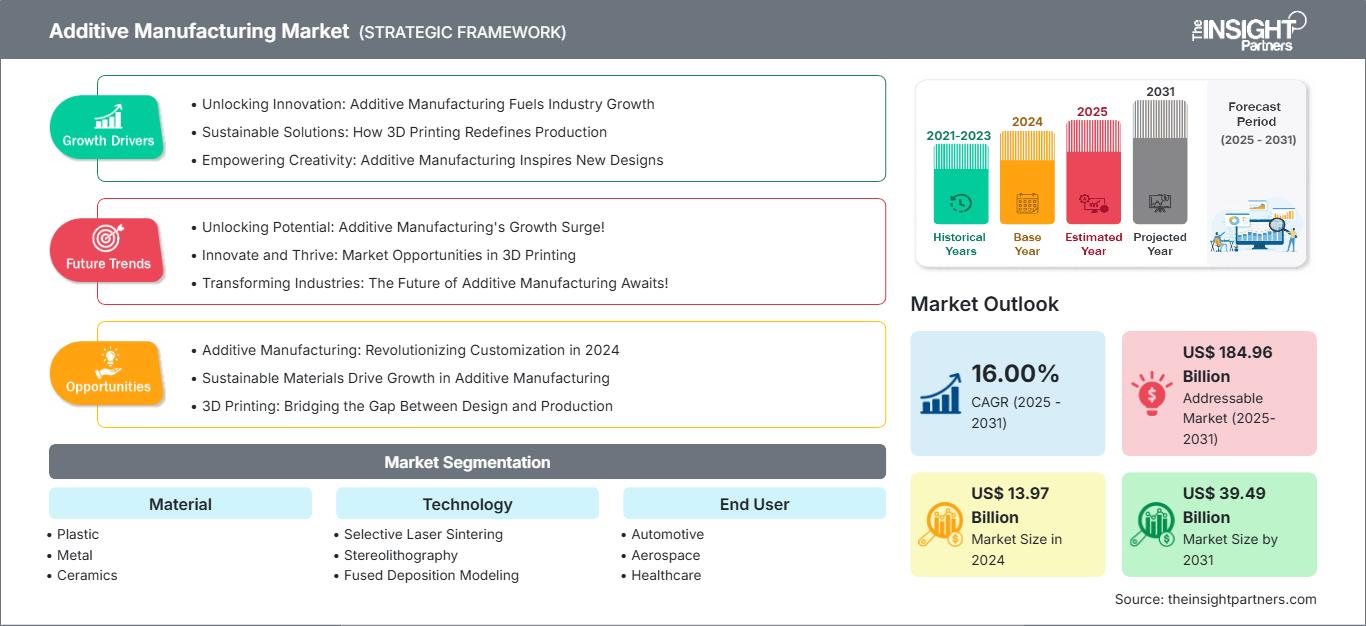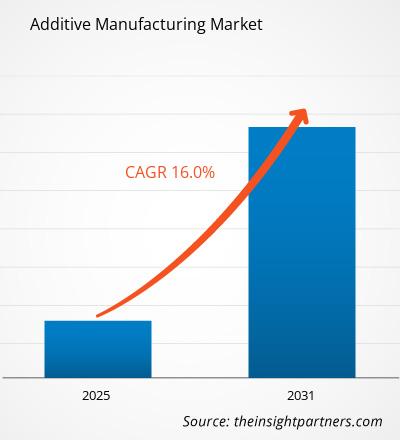Für den Markt für additive Fertigung wird von 2025 bis 2031 eine durchschnittliche jährliche Wachstumsrate (CAGR) von 16,00 % erwartet, wobei die Marktgröße von 13,97 Milliarden US-Dollar im Jahr 2024 auf 39,49 Milliarden US-Dollar im Jahr 2031 anwachsen wird.
Der Bericht ist nach Materialien (Kunststoff, Metall, Keramik) kategorisiert und analysiert den Markt anhand der Technologie (Selektives Lasersintern, Stereolithografie, Fused Deposition Modeling). Er untersucht den Markt auch nach Endverbrauchern (Automobilindustrie, Luft- und Raumfahrt, Gesundheitswesen, industrielle Fertigung). Für jedes dieser Schlüsselsegmente wird eine umfassende Aufschlüsselung auf globaler, regionaler und Länderebene bereitgestellt.
Der Bericht enthält Marktgrößen und Prognosen für alle Segmente und stellt die Werte in US-Dollar dar. Er liefert außerdem wichtige Statistiken zur aktuellen Marktsituation führender Akteure sowie Einblicke in aktuelle Markttrends und neue Chancen.
Zweck des Berichts
Der Bericht „Additive Manufacturing Market“ von The Insight Partners beschreibt die aktuelle Marktsituation und das zukünftige Wachstum sowie die wichtigsten treibenden Faktoren, Herausforderungen und Chancen. Er liefert Einblicke für verschiedene Geschäftsinteressenten, wie zum Beispiel:
- Technologieanbieter/-hersteller: Um die sich entwickelnde Marktdynamik zu verstehen und die potenziellen Wachstumschancen zu kennen, können sie fundierte strategische Entscheidungen treffen.
- Investoren: Durchführung einer umfassenden Trendanalyse hinsichtlich der Marktwachstumsrate, der finanziellen Marktprognosen und der Chancen entlang der Wertschöpfungskette.
- Regulierungsbehörden: Sie regulieren die Richtlinien und polizeilichen Aktivitäten auf dem Markt mit dem Ziel, Missbrauch zu minimieren, das Vertrauen der Anleger zu wahren und die Integrität und Stabilität des Marktes aufrechtzuerhalten.
Marktsegmentierung für additive Fertigung
Material
- Plastik
- Metall
- Keramik
Technologie
- Selektives Lasersintern
- Stereolithographie
- Fused Deposition Modeling
Endbenutzer
- Automobilindustrie
- Luft- und Raumfahrt
- Gesundheitspflege
- Industrielle Fertigung
Sie erhalten kostenlos Anpassungen an jedem Bericht, einschließlich Teilen dieses Berichts oder einer Analyse auf Länderebene, eines Excel-Datenpakets sowie tolle Angebote und Rabatte für Start-ups und Universitäten.
Markt für additive Fertigung: Strategische Einblicke

-
Holen Sie sich die wichtigsten Markttrends aus diesem Bericht.Dieses KOSTENLOSE Beispiel umfasst Datenanalysen, die von Markttrends bis hin zu Schätzungen und Prognosen reichen.
Wachstumstreiber des Marktes für additive Fertigung
- Innovationen freisetzen: Additive Fertigung treibt Branchenwachstum an
- Nachhaltige Lösungen: Wie 3D-Druck die Produktion neu definiert
- Kreativität fördern: Additive Fertigung inspiriert zu neuen Designs
Zukünftige Trends im Markt für additive Fertigung
- Potenziale freisetzen: Der Wachstumsschub der additiven Fertigung!
- Innovation und Erfolg: Marktchancen im 3D-Druck
- Branchen im Wandel: Die Zukunft der additiven Fertigung erwartet Sie!
Marktchancen für die additive Fertigung
- Additive Fertigung: Revolutionierung der Individualisierung im Jahr 2024
- Nachhaltige Materialien treiben das Wachstum in der additiven Fertigung voran
- 3D-Druck: Die Lücke zwischen Design und Produktion schließen
Regionale Einblicke in den Markt für additive Fertigung
Die Analysten von The Insight Partners haben die regionalen Trends und Faktoren, die den Markt für additive Fertigung im Prognosezeitraum beeinflussen, ausführlich erläutert. In diesem Abschnitt werden auch die Marktsegmente und die geografische Lage in Nordamerika, Europa, dem asiatisch-pazifischen Raum, dem Nahen Osten und Afrika sowie Süd- und Mittelamerika erörtert.
Umfang des Marktberichts zur additiven Fertigung
| Berichtsattribut | Details |
|---|---|
| Marktgröße im Jahr 2024 | 13,97 Milliarden US-Dollar |
| Marktgröße bis 2031 | 39,49 Milliarden US-Dollar |
| Globale CAGR (2025 – 2031) | 16,00 % |
| Historische Daten | 2021–2023 |
| Prognosezeitraum | 2025–2031 |
| Abgedeckte Segmente |
Nach Material
|
| Abgedeckte Regionen und Länder |
Nordamerika
|
| Marktführer und wichtige Unternehmensprofile |
|
Marktteilnehmerdichte im Bereich Additive Fertigung: Auswirkungen auf die Geschäftsdynamik verstehen
Der Markt für additive Fertigung wächst rasant. Die steigende Nachfrage der Endverbraucher ist auf Faktoren wie veränderte Verbraucherpräferenzen, technologische Fortschritte und ein stärkeres Bewusstsein für die Produktvorteile zurückzuführen. Mit der steigenden Nachfrage erweitern Unternehmen ihr Angebot, entwickeln Innovationen, um den Bedürfnissen der Verbraucher gerecht zu werden, und nutzen neue Trends, was das Marktwachstum weiter ankurbelt.

- Erhalten Sie einen Überblick über die wichtigsten Akteure auf dem Markt für additive Fertigung
Wichtige Verkaufsargumente
- Umfassende Abdeckung: Der Bericht deckt die Analyse von Produkten, Dienstleistungen, Typen und Endbenutzern des Marktes für additive Fertigung umfassend ab und bietet eine ganzheitliche Landschaft.
- Expertenanalyse: Der Bericht basiert auf dem umfassenden Verständnis von Branchenexperten und Analysten.
- Aktuelle Informationen: Der Bericht gewährleistet Geschäftsrelevanz durch die Berichterstattung über aktuelle Informationen und Datentrends.
- Anpassungsoptionen: Dieser Bericht kann angepasst werden, um den spezifischen Kundenanforderungen gerecht zu werden und die Geschäftsstrategien optimal zu unterstützen.
Der Forschungsbericht zum Markt für additive Fertigung kann daher dazu beitragen, die Branchensituation und die Wachstumsaussichten zu entschlüsseln und zu verstehen. Obwohl es einige berechtigte Bedenken geben mag, überwiegen die Vorteile dieses Berichts tendenziell die Nachteile.
- Historische Analyse (2 Jahre), Basisjahr, Prognose (7 Jahre) mit CAGR
- PEST- und SWOT-Analyse
- Marktgröße Wert/Volumen – Global, Regional, Land
- Branchen- und Wettbewerbslandschaft
- Excel-Datensatz
Aktuelle Berichte
Erfahrungsberichte
Grund zum Kauf
- Fundierte Entscheidungsfindung
- Marktdynamik verstehen
- Wettbewerbsanalyse
- Kundeneinblicke
- Marktprognosen
- Risikominimierung
- Strategische Planung
- Investitionsbegründung
- Identifizierung neuer Märkte
- Verbesserung von Marketingstrategien
- Steigerung der Betriebseffizienz
- Anpassung an regulatorische Trends






















 Kostenlose Probe anfordern für - Markt für additive Fertigung
Kostenlose Probe anfordern für - Markt für additive Fertigung